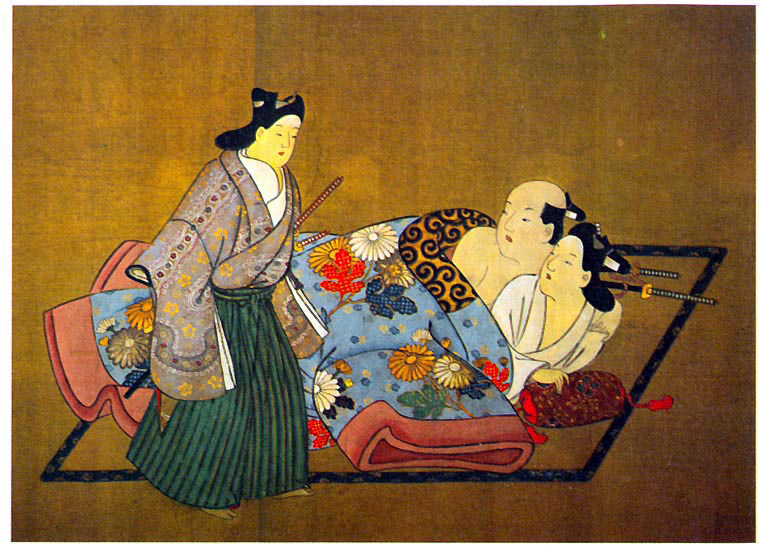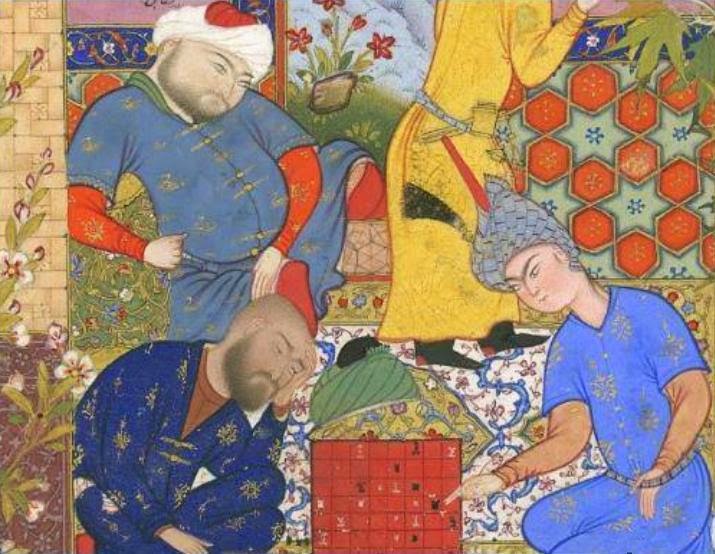(no subject)

Three Samurai
Miyakawa Choshun (1682–1753), The Flowered Robe

Katanas Ready
Miyakawa Choshun
(1682–1753)

Nanshoku-type tryst between a samurai and a boyfriend. Young kabuki
actors who played female roles were known as onnagata or kagema and
doubled as sex workers. They were much sought after by the
sophisticates of the day. Miyagawa Isshô, ca. 1750; Shunga hand scroll
(kakemono-e); sumi, color and gofun on silk. Private collection.

Actors on stage and in bed

18th Century Japanese print of a man with his young male lover in pederastic scene

Male Couple; Kitagawa Utamaro 1753 – 1806; c. 1802

Young men engaged in erotic play.
Hand scroll, opaque watercolor on paper.
Beijing, Qing dynasty, late 19th c.

Woman spying on male lovers, Qing-Dynastie

Beijing Hand Scroll
Young men engaged in erotic play.
Anonymous. Hand scroll, opaque watercolor on paper. Private collection.
Beijing, Qing dynasty, late 19th c. peking

Young men drinking, reading poetry, and making love.
China, Qing dynasty (18th–19th c.)
Individual panel from a hand scroll on homosexual themes, paint on silk.


Under the Mulberry Tree
Panel from
Spring Flowers and Autumn Moon.
Ming dynasty album.
Paint on paper.

Persian youth playing chess with two of his suitors. Illustration to the "Haft Awrang" of Jami, in the story A Father Advises his Son About Love.

This is a detail from a scene for poem #5, Chain of Gold, the chapter named A Father Advises his Son About Love. In it, a handsome youth asks his father how to chose the best from among his many male suitors. The father answewrs by reciting a list of the usual physical characteristcs that will draw lovers, but advises his son to chose that man who sees beyond the mere physical and expresses a love for his inner qualities.
The work is a series of alegorical romances and moral parables in the tradition of Sufi mysticism.
Miniature illustration from the Haft Awrang, Seven Thrones, of Jami, in an illuminated manuscript produced between 1556 and 1565 at Mashhad, Iran, on the comission of the Prince Sultan Ibrahim Mirza, brotherin law to Shah Tahmasb.

Riza i-Abbasi
Two Lovers
Painted ca. 1630 in the royal studio
of Shah Abbas I (1588–1629).

Youths Embracing in a Garden
Anonymous painting in gold and color on paper. Safavid dynasty (1501-1732), Iran.


Sheykh Propositioning Youth
Old man waggles tongue
and makes a suggestive gesture
to an interested youth.
Isfahan, Iran,
Safavid Dynasty, ca. 1605

India. Two men and woman have sex together.

Hermit monk performing
auparashtika
on a princely visitor.
Temple of Chhapri,
Central India,
12th century CE.
This photograph depicts a tradition of homoerotic sacred art now mostly effaced from Indian temples as a result of the systematic campaigns of “sexual cleansing” of Mahatma Gandhi and Jawaharlal Nehru, both of whom attempted to re-write the historical record by erasing all traces of the Indian homoerotic tradition.

Mayan same-sex love pederastic couple.
Reproduction of Mayan painting

Vasco Núñez de Balboa executing Native Americans for same-sex love.

William Blake
(1757-1827)
Glad Day
c. 1794
pics and captions stolen from http://commons.wikimedia.org/wiki/Homosexuality_%28non-Western%29 and http://www.androphile.org/preview/Museum/museum.htm